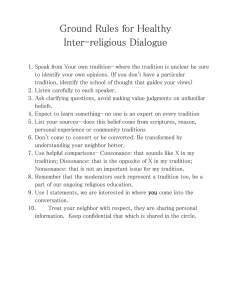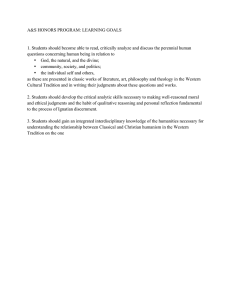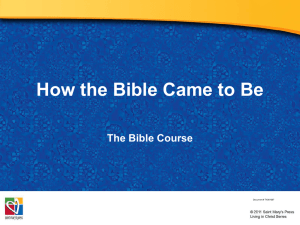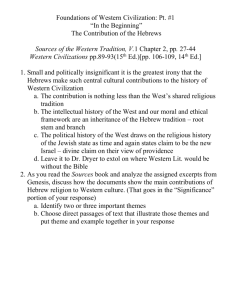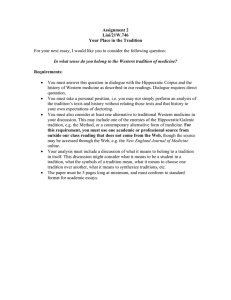Cultural Change Phenomena
advertisement
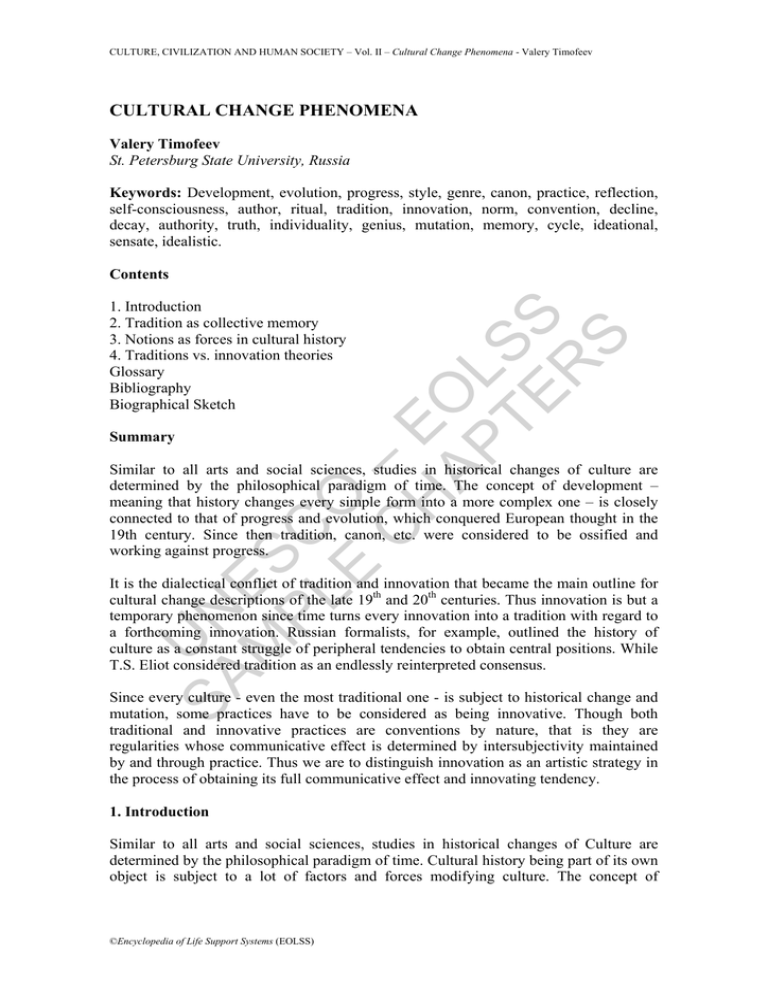
CULTURE, CIVILIZATION AND HUMAN SOCIETY – Vol. II – Cultural Change Phenomena - Valery Timofeev CULTURAL CHANGE PHENOMENA Valery Timofeev St. Petersburg State University, Russia Keywords: Development, evolution, progress, style, genre, canon, practice, reflection, self-consciousness, author, ritual, tradition, innovation, norm, convention, decline, decay, authority, truth, individuality, genius, mutation, memory, cycle, ideational, sensate, idealistic. Contents U SA N M ES PL C E O– C E H O AP L TE SS R S 1. Introduction 2. Tradition as collective memory 3. Notions as forces in cultural history 4. Traditions vs. innovation theories Glossary Bibliography Biographical Sketch Summary Similar to all arts and social sciences, studies in historical changes of culture are determined by the philosophical paradigm of time. The concept of development – meaning that history changes every simple form into a more complex one – is closely connected to that of progress and evolution, which conquered European thought in the 19th century. Since then tradition, canon, etc. were considered to be ossified and working against progress. It is the dialectical conflict of tradition and innovation that became the main outline for cultural change descriptions of the late 19th and 20th centuries. Thus innovation is but a temporary phenomenon since time turns every innovation into a tradition with regard to a forthcoming innovation. Russian formalists, for example, outlined the history of culture as a constant struggle of peripheral tendencies to obtain central positions. While T.S. Eliot considered tradition as an endlessly reinterpreted consensus. Since every culture - even the most traditional one - is subject to historical change and mutation, some practices have to be considered as being innovative. Though both traditional and innovative practices are conventions by nature, that is they are regularities whose communicative effect is determined by intersubjectivity maintained by and through practice. Thus we are to distinguish innovation as an artistic strategy in the process of obtaining its full communicative effect and innovating tendency. 1. Introduction Similar to all arts and social sciences, studies in historical changes of Culture are determined by the philosophical paradigm of time. Cultural history being part of its own object is subject to a lot of factors and forces modifying culture. The concept of ©Encyclopedia of Life Support Systems (EOLSS) CULTURE, CIVILIZATION AND HUMAN SOCIETY – Vol. II – Cultural Change Phenomena - Valery Timofeev U SA N M ES PL C E O– C E H O AP L TE SS R S development – a causally interconnected sequence of change resulting over a time emerging from a more complex situation – is one of the notions along with “process”, “trend”, “movement” that have long been part of Western thought. Since the nineteenth century this association, enriched by the ideas of “evolution” and “progress” has been especially close, becoming the principal assumption of Western thought and a basic framing concept for the humanities in Europe and America. This kind of thinking is easy enough to understand, but tends to downgrade early stages in any evolutionary sequence. Should historical changes of culture be described in evolutionary terms, then the idea that “Artistic Evolution is not always orderly” (Hartt) would be inevitable. It is rather difficult to explain in evolutionary terms the sudden decline in interest in the naturalistic representation of the human figure and the surrounding world in the late Roman art as compared to the subtle complex, and complete Greek and early Roman systems of representation, which had just preceded this period. “It looks as if the evolutionary clock had been turned backward from the complex to the simple” (Hartt). The pattern of continuous improvement that is believed to underlie the cultural historical process is assumed to contain tradition and innovation as dominant agents. The idea of progress is inevitably linked to that of decline and decay (as its reverse or darker side). Since ancient times, the idea of the decay and dissolution of human cultures has been a central theme of historical analysis. The 16th century Italian artist and probably the first art historian, Giorgio Vasari, compared the development of art to the life of a human being, saying that arts “like human bodies, have their birth, their growing up, their growing old and their dying”. Implicit in such thinking is the idea of a summit of perfection beyond which no culture can ascend, and from which the way leads only downward. As Nicola Machiavelli wrote in 1532: “since nature has not allowed worldly things to remain still, when they arrive at their final perfection, they have no future to climb and so they have to descend.” Similar ideas belonging to G. Vico and others will be discussed later. The connotations of the terms might differ radically depending on whether cyclical, linear or combined notion of process - among other factors – underlies a particular doctrine. (see Traditions, innovations and discontinuations in the development of cultures) Tradition has always – long before if was reflected as capable of that – functioned as a norm-maintainer. Tradition is a general name for institutions, principles and their vehicles such as canons, codes, iconographic handbooks etc. of authority or/and accumulated experience handed down by God (s) or/and ancestors. While Innovation has at least two meanings 1. A tendency or trend that provides cultural practice with novelty 2. An artistic device or cultural practice new in relation to the reigning ones in a particular culture of a certain time. A culture that is to assimilate a new artistic device in practice – no matter whether it is deliberate (i.e. resulting in an individual choice of an artist) or unintended - should contain a tendency or trend, being a set of ideas, principles and notions, to maintain new devices and practices. Interconnection of innovation and tradition in terms of degree of novelty as well as conformity to tradition must always have been of importance for culture. The degree of novelty might be different depending upon the period of culture ©Encyclopedia of Life Support Systems (EOLSS) CULTURE, CIVILIZATION AND HUMAN SOCIETY – Vol. II – Cultural Change Phenomena - Valery Timofeev U SA N M ES PL C E O– C E H O AP L TE SS R S and the sphere where the novelty is admitted. Thus in the area of religion, until modern times, once the canon of sacred books is established, novelty can enter only through interpretive and critical commentary. The first early medieval non-biblical canon was patristic, followed by the medieval auctores, list for school study of authors both of Christian and pagan faiths. In this case the term “canon” meant not merely selected, but also authoritative. The education one received depended on the authors included in the available curriculum. As Curtius states: “Education becomes the medium of literary tradition.” Except for the inevitable Christian – pagan tension – often alleviated by allegorical accommodation of pagan to Christian – this canon remained relatively uncontroversial, until the rise of the vernacular languages in the Renaissance motivated the change of canon. Subsequently, in the 17th and 18th centuries, canon was formulated from national and comparative perspectives alike, and usually canons were explicitly linked to cultural values: Samuel Johnson emphasized the necessity of balancing the novel and the truth. As in the 19th and the early 20th centuries Mattern Arnold called to the pursuit of the best that is known and thought that yet generates a current of true and fresh ideas, or T.S. Eliot who produced a concept of tradition reordered by each work. The central factors in canon formation, as it is agreed upon by most of culture historians, are ideological, religious, and aesthetic values in particular and complex combinations. However there is inexorable change of beliefs, aims, methods, vocabularies, and standards over the course of time. The collective ideology changes, and so does a system of norms of ideal intersubjective concepts which they are part of. As B.H. Smith argued in “Contingencies of Value” that the evaluative processes that produce canons ultimately respond to changing cultural functions that are constant interaction with the changing social environment. Panofsky (Panofsky, Erwin (1862-1968) is renowned particularly for his immensely learned contributions to the study of iconography. He made a distinction of types of innovations in relation to the development of visual arts from the Middle Ages to Modern time. Panofsky distinguished the transformations in depiction of existing themes and types as being either of a general or a specific nature. An example of general transformation is the development at the end of the Middle Ages from iconic to narrative representation, not just in the Man of Sorrows, but also of the Passion in general. A specific transformation, or “pseudomorphosis”, is exemplified as “classical personifications that, having acquired a non-classical expression during the Middle Ages, preserved aspects of the intervening medieval phase when restored to their Classical form” (Panofsky). In terms of tendencies as sets of principles, ideas and notions being current at time it might be said that in both cases in the defined period a great change of worldview principles took place. Some themes were developed in accordance with a new set of ideas and the corresponding canonized image formulae seemed irrelevant, losing its binding force as in the case of general transformation, while other image formulae retained their force revealing arbitrary conventionality in the way they were used by preserving “aspects of the intervening medieval phase” and thus staying thematically shallow. As it seems ©Encyclopedia of Life Support Systems (EOLSS) CULTURE, CIVILIZATION AND HUMAN SOCIETY – Vol. II – Cultural Change Phenomena - Valery Timofeev U SA N M ES PL C E O– C E H O AP L TE SS R S when looked at with the eyes of strange for that time cultural paradigm ideas coined in late 19-20-th centuries. Whereas for the eyes of the period of the defined transformation the situation of arbitrariness and conventionality was rather vice versa. Due to a great change in the source of authority of ideas and notions including that of artistic truth from Divine to Human stemmed at the time only to rush forward to reign in the forthcoming centuries, the role of artist’s individuality started to change radically. Now it is commonly acknowledged that in the defined period variations in an established scheme appear whenever the contribution of the artist’s individuality is greater than that of a Tradition. That means that instead of established convention the innovating artist introduces arbitrarily a new one. The latter would need the recognition by a new generation of artists and public that is time and regularity in usage and perception to replace the former effectively. Meanwhile the conventions used in cases of “pseudomorphosis” belonged to the list of the established ones and thus were generally recognized at the time. Their conventionality would have to show up later, much later, when the list of conventions in use would change dramatically. The term “convention” and “conventionality” was used above revealing two following meanings: 1. Akin to that in law and diplomacy, is that of a stated or tacit agreement providing for limits and permissions: that while accepted rules operate, certain things will stand for certain realities. 2. Is an expression of a negative judgment connoting obsolesce or triteness, often asserted polemically in order to replace conventions of which the attacker is painfully conscious with convention of which he is not conscious at all. - - TO ACCESS ALL THE 12 PAGES OF THIS CHAPTER, Visit: http://www.eolss.net/Eolss-sampleAllChapter.aspx Bibliography ELIOT, T.S. Tradition and the Individual Talent – Selected Essays. – London, 1932. [on the canon, linked to cultural values, and the concept of tradition reordered by each new work, an endlessly reinterpreted consensus]. FOUCAULT, MICHEL The Order of Things. – London, 1970. [on the cognitive schemes employed in the classical age of enlightenment and the subsequent changes] FRYE, N. On Culture and Literature. – Chicago. London, 1978. GABLICK, SUZI Progress in Art. – London, 1976. [is the concept of “progress” useful, if applied to art?] GOMBRICH, E. Norm and Form. – L., 1971. [on the problem of “norms” in art and criticism] ©Encyclopedia of Life Support Systems (EOLSS) CULTURE, CIVILIZATION AND HUMAN SOCIETY – Vol. II – Cultural Change Phenomena - Valery Timofeev HARTT, FREDERICK Art: A History – In 2 Vols. – N.Y., 1989. [historical changes of culture in evolutionary terms, artistic evolution is not always orderly] HAUSER, A. The Philosophy of Art History. - L., 1959. [influential work on the relation between art and society] LEACH E. Culture and Communication. – Cambridge, 1976. LEWIS D. Convention. – Cambridge (Mass), 1969. [on conventions and norms] On Convention: A Discussion In: New Literary History. Charlottesville. 1981. – Vol.13. - # 1; Vol.14. - # 2. SOROKIN, P. Social and Cultural Dynamics. A Study of Change in Major Systems of Art, Ethics, Law and Social Relationship. – Boston, 1957. [Cultural phenomena have two aspects: Internal which he termed mentality and external, the organic and inorganic phenomena that manifest and externalize the internal aspect ] U SA N M ES PL C E O– C E H O AP L TE SS R S WELLEK, R. The Concept of Evolution in Literary History // The Concepts of Criticism. NewHeaven – London, 1967. WÖLFFLIN, HEINRICH Principles of Art History. – N.Y., 1946. [Is the change in the forms of apprehension the result of an inward development, or is it an impulse from outside, which determines the change?] Biographical Sketch Valery Timofeev Senior lecturer at the department of the History of Western Literature of St Petersburg State University. He was born in Vyborg in 1957 and educated at Vyborg English Language School and St. Petersburg State University. He majored in English language and literature. He taught English at St. Petersburg University until 1991 when he started lecturing Western Literature at the same University. His MA thesis was “The Gormenghast Trilogy by Mervyn Peake” followed by PhD thesis “The didactics of John Fowles”. His major publications are devoted to the theory and history of literature and culture - drawing support for his position from diverse sources in sociology, Rezeption Theory and cognitive science - Russian literature and literature in English paying special attention to the main tendencies of the Twentieth Century Literary process that of Modernism and Post-Modernism. ©Encyclopedia of Life Support Systems (EOLSS)

